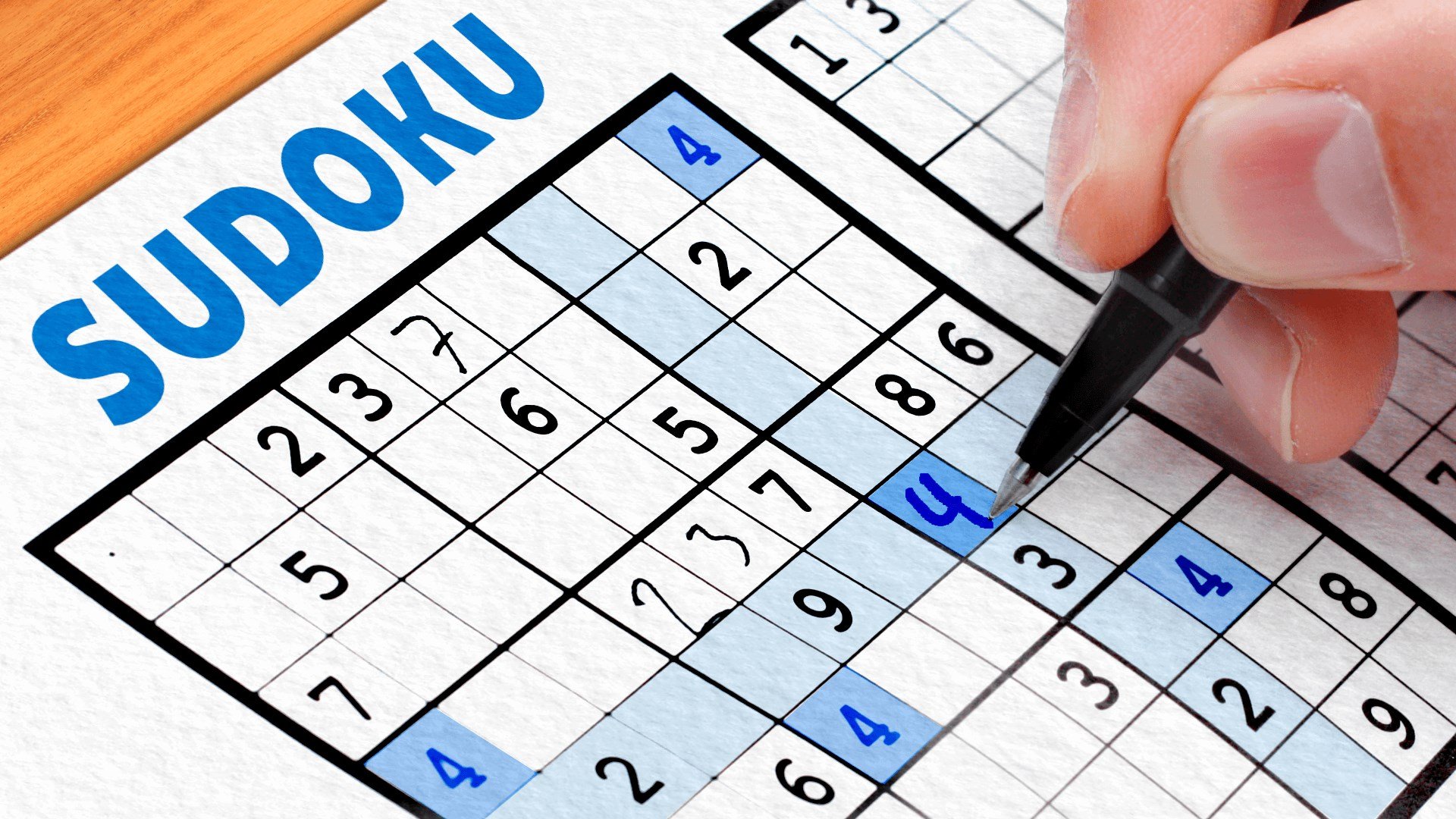Sudoku is a super popular number puzzle game. The goal is to fill in the empty boxes on a 9×9 grid. The boxes are arranged in 9 rows, 9 columns, and 9 3×3 boxes.
What is Sudoku?

Sudoku, the beloved number puzzle, has captivated minds around the world for decades. Its seemingly simple rules and deceptively challenging nature offer a unique blend of logic and fun. This guide delves into the fascinating world of Sudoku, equipping you with everything you need to become a master puzzler.
Sudoku, meaning “single number” in Japanese, is played on a 9×9 grid divided into nine smaller 3×3 sub-grids called “boxes.” The objective? Fill the grid with numbers 1 through 9, ensuring that each number appears only once in each row, column, and box.
Here’s a breakdown of the key elements:
- Grid: The 9×9 playing field forms the foundation of the puzzle.
- Cells: Each individual square within the grid is called a cell.
- Numbers: The digits 1 through 9 are the players’ tools to solve the puzzle.
- Rows: There are nine horizontal rows, each containing the numbers 1 through 9 exactly once.
- Columns: There are nine vertical columns, again with each number appearing only once.
- Boxes: The nine 3×3 sub-grids are crucial for placing numbers strategically.
How to Play Sudoku
You fill in the grid with the numbers 1 through 9. But here’s the tricky part – each number can only appear once in each row, column, and 3×3 box. No number can repeat!
It may sound hard, but the rules are quite simple. The numbers that are already placed on the grid are called the “givens.” Your job is to use logic to figure out where the other numbers go.
To get started, scan each row, column, and 3×3 box. See which numbers are missing. Those are the ones you need to fill in. But be careful – you can’t repeat any numbers in that row, column, or box.
Look for boxes that have lots of givens around them. Those will be the easiest to solve first. As you place new numbers, it will open up more possibilities for the remaining empty squares.
Remember, there is only one correct solution for each sudoku puzzle. So if you get stuck, you’ll need to backtrack and rethink your approach. Don’t guess randomly!
Sudoku looks intimidating at first glance. But once you understand the basic rules, it just takes patience, persistence, and logic to solve the grids. Start with easy puzzles until you get the hang of it.
The best part about sudoku is that it exercises your brain in a fun way. Solving the puzzles can improve skills like concentration, deductive reasoning, and analytical thinking. Plus it’s super satisfying to fill in that last number!
Ways to Play Sudoku
Let’s explore some of the top options for playing sudoku online, with printable puzzles, and on apps.
Sudoku Online
One of the easiest ways to play sudoku is online through free websites. Sites like WebSudoku.com, Daily-Sudoku.com, and Sudoku.com offer unlimited free sudoku puzzles that you can solve right in your web browser. No downloads or signup required – just open the site and start playing! Most of these free sudoku website have options for easy, medium, hard, and even evil difficulty levels to challenge solvers of all skills.
If you prefer more of a game-like experience, there are also many free online sudoku games. Web games like Sudoku.com give you a slick interface with features like notes, highlights, error checking and more. Some let you play against the clock or compete with friends online. Free online sudoku makes it easy to enjoy a quick puzzle wherever you have internet access.
Printable Sudoku Puzzles
For those who prefer the classic pen-and-paper solving experience, printable sudoku puzzles are the way to go. You can find tons of free printable sudoku puzzle PDFs online to download and print on standard computer paper. Sites offer printable sudoku in a variety of styles – like print sudoku 6 per page or large print sudoku books. Perfect for playing sudoku anywhere without an internet connection.

Printable sudoku puzzle books are also very popular and make a great portable option. These inexpensive printed booklets contain hundreds of puzzles ranging from easy sudoku for kids or beginners up to devilishly hard sudoku for experts. Just grab a pencil and you’re ready to solve!
Sudoku Apps
In today’s mobile world, sudoku apps are one of the most convenient ways to play. The best sudoku apps for iPhone and Android offer unlimited sudoku puzzles that you can solve anytime, anywhere on your phone or tablet. Many top apps like Sudoku Joy even let you play offline too.
When it comes to sudoku mobile apps, you have the choice of free apps with ads or upgrade to a paid premium version without ads. The free sudoku apps with ads are a great option if you don’t mind seeing promos between puzzles. But sudoku without ads provides a smoother, distraction-free experience and typically unlocks additional features like unlimited notes, hints, and even alternate sudoku variants.
Other standout paid sudoku apps include Sudoku GameHouse which has a great tutorial for beginners. Or Andoku for a minimalist yet powerful solving experience. You’ll find both free and paid sudoku apps for Android and iOS to fit any preference or budget.
Sudoku Game Development
For those who really want to take sudoku to the next level, you can even develop your own custom sudoku games and puzzles using programming tools. Studios like eJaw allow you to create and customize sudoku puzzles from scratch or modify existing ones. With EJaW and similar sudoku makers, you have full control over the grid size, starting givens, symmetry, and difficulty level.
Advanced users can apply techniques like forcing chains and unique rectangles to construct diabolically tough sudoku challenges. Or keep it simple for beginner-friendly easy sudoku puzzles. Once created, you can print the sudoku grids, solve them online, or even integrate them into a website or app. Making your own sudoku variants is a fun way for coding fans and sudoku masters to flex their skills.
Sudoku Levels
There’s a puzzle out there for every skill level. From simple grids that are perfect for beginners to brain-melting challenges for the most elite solvers, sudoku offers an endless variety of difficulties. Let’s take a look at the main categories.
Easy Sudoku
Easy sudoku puzzles make an excellent starting point for those new to the game. These grids typically have about 30-35 givens already filled in, providing ample clues to logically deduce the rest of the solution. Easy sudoku is also great for seniors or others looking for a gentle mental exercise. Large print sudoku books with bigger boxes can make these puzzles even more accessible.
If easy still feels too tough at first, you can look for “sudoku for juniors” or use tools like color coded sudoku balls or cells to differentiate the boxes. The key with easy sudoku is to go step-by-step, paying careful attention to the “naked” singles – cells where only one number is a valid choice.
Medium Sudoku
Once you’ve mastered the basics, it’s time to level up to medium difficulty sudoku. These grids have around 25-30 givens, leaving more deduction work for the solver. You’ll need to employ advanced techniques like counting candidates in boxes and using intersections to spot the right number placements.
Many enjoy the goldilocks zone of medium sudoku – providing an engaging challenge without descending into hair-pulling frustration. They’re nice changeup from easy sudoku but not too extreme. You can find lots of free medium sudoku puzzles online and in printed books too.
Hard Sudoku
Ah, the dreaded hard sudoku category. These evil grids have just 21-27 givens, requiring serious logic skills and patience to crack. You’ll likely need to identify hidden pairs, triples, and quads just to make a dent in these fiendish puzzles. Tactics like X-Wings, Y-Wings, and coloring become essential sodoku solver tools.
Hard sudoku separates the casual players from the devoted sudoku masters. Completing a legitimately hard puzzle is immensely satisfying – though you may need to put pencil to paper (or use an online notes feature) to find the solution. Some of the hardest sudoku puzzles have taken years for teams to solve!
Evil or Extreme Sudoku
Finally, at the far end of the sudoku difficulty spectrum, we enter the realm of evil and extreme sudoku. These grids are the stuff of nightmares for most solvers, with a mere 17-21 givens spread across the puzzle. You’ll need every trick in the sudoku book, from simple filling to complex techniques like X-Cycles and Uniqueness tests.
Evil sudoku puzzles are for the most hardcore players only. They can take hours or days to solve legitimately – even for experts. Unless you truly live for the masochistic thrill of the most cruelly designed sudoku variations, you may want to avoid these satanic grids! For most people, hard sudoku is more than difficult enough.
Sudoku Variations
While the traditional 9×9 sudoku grid is wildly popular, the puzzle has evolved to feature all kinds of creative twists and variations. From different grid sizes to irregular shapes and alternative logic rules, these sudoku variants keep things interesting for diehard solvers. Let’s explore some of the most fun sudoku puzzles out there.
Different Grid Sizes
One of the most common sudoku variations is simply changing the grid dimensions from the standard 9×9 square. Smaller 4×4 or 6×6 grids make for easy sudoku puzzles that are great for kids or beginners. On the other extreme, you have larger 12×12 or even 16×16 grids that ramp up the difficulty significantly with more rows, columns, and boxes to deduce. Mastering these different size variations is a fun challenge.
Irregular Shapes
Who says a sudoku puzzle has to be a basic square grid? Irregular shape sudoku mixes things up with unorthodox layouts like circular, diamond, hexagonal, and other wacky configurations. These non-traditional shapes add an extra layer of deductive reasoning as you can’t simply rely on the usual row/column/box techniques. Shape sudoku games are unique brain-twisters.
Math Sudoku
While standard sudoku uses the numbers 1-9, math sudoku substitutes basic arithmetic operations instead: addition, subtraction, multiplication and division. To solve these grids, you need to look at the equations rather than individual digits. For example, a row with (4+3) and (7×1) can’t have the result “7” appear. Math sudoku adds an algebraic twist!
Other Twists
Those are just the start of quirky sudoku variants. Word sudoku replaces numbers with letters that form words or phrases for an extra linguistic layer. Jigsaw sudoku has you physically reconstructing a scattered grid. And sudoku-wordle hybrids like Xwords combine the logical reasoning of sudoku with the clever word puzzle gameplay of Wordle.
There’s even options to customize the required set for a sudoku grid. Instead of 1-9, maybe you want to solve a hexadecimal sudoku with values 0-F. Or quote sudoku where you place famous sayings and phrases into the grid. The possibilities are endless!
No matter which variant you try, these unconventional sudoku puzzles encourage you to pick up new strategies and approaches beyond simple box/row/column checking. They keep your mind nimble and flexible as you navigate the added layers of logical constraints. Sudoku lovers are constantly crafting new creative ways to modify the core concept too.
So once you’ve maxed out on traditional sudoku grids, don’t be afraid to explore different grid sizes, irregular shapes, math operations, and the many other sudoku twists waiting to be discovered. Who knows, you may just uncover your new favorite sudoku variant!
Sudoku Development in the Future
The future of sudoku looks brighter than ever as this classic logic puzzle continues evolving and finding new fans. From cutting-edge AI sudoku solvers to unique new variations, expect sudoku to stick around for years to come.
New Sudoku Variations
While standard 9×9 sudoku will likely remain the most popular format, creative new twists on the game keep things fresh. Expect to see more irregular shape sudoku grids beyond basic squares and rectangles. Curved, circular, and asymmetrical sudoku layouts make for mind-bending puzzles.
We’ll also probably get sudoku variants that ditch numbers entirely. Word sudoku using letters and quotes is a prime example. Or variants where you place graphic icons, colors, or patterns into the cells instead of digits. The possibilities are endless!
Sudoku could even merge with other popular puzzles and games down the road. Picross sudoku? Tetris sudoku? Wordle sudoku mashups? The sky’s the limit for new creative sudoku spinoff concepts. Puzzlemakers are always dreaming up clever new takes.
AI and Sudoku
While humans construct most commercial sudoku puzzles today, AI is increasingly being used to generate and solve sudoku grids. Machine learning algorithms can rapidly design, rank, and validate new sudoku puzzles at scale. Some of the hardest sudoku ever will likely come from advanced AI systems.
AI can also provide custom hints and tutoring for players learning sudoku strategy. As artificial intelligence advances, it may even become a virtual sudoku coach or competitor. Imagine an AI sudoku tutor program that studies your solving methods and gives personalized feedback!
Popularity Trends of Sudoku Gaming
After decades as a beloved logic puzzle, sudoku shows no signs of declining popularity anytime soon. If anything, sudoku’s popularity may continue growing thanks to increased visibility across media platforms. Sudoku video content has thrived on YouTube, Twitch, and other streaming sites. More sudoku mobile apps, tutorials, and puzzlebooks hit the market each year.
As younger generations discover and embrace sudoku, the overallPlayer base should expand. Students are learning sudoku fundamentals in school math classes. And seniors have made sudoku a favorite pastime thanks to its deduced cognitive benefits.
Between new variants, artificial intelligence’s impact, and a growing fanbase across all ages, sudoku’s future has never looked brighter. The addictive logic puzzle will continue capturing our minds and providing an oasis of calm problem-solving for decades more.
Modern Sudoku Game Development
The wealth of information and insight provided about sudoku lays an excellent foundation for developers looking to create sudoku games and apps. From understanding the core gameplay to grasping variations and difficulties, this knowledge proves invaluable when designing an engaging sudoku experience. Let’s explore how to utilize these details for crafting compelling sudoku games.
Mastering the Basics
Before diving into development, having a firm grasp of sudoku’s rules and solving techniques is crucial. The overview covering what sudoku is, its components like grids/cells/numbers, and the constraints around rows/columns/boxes forms the bedrock. Developers should thoroughly understand solving strategies like scanning for missing numbers, identifying “naked” singles, and basic logic deduction. Nailing these fundamentals ensures the game adheres accurately to sudoku principles.
Implementing Difficulties
A key aspect is properly implementing the different sudoku difficulty levels – easy, medium, hard, evil/extreme. Developers can use the guidelines around number of starting givens (e.g. 30-35 for easy, 17-21 for evil) and techniques required to generate puzzles at each tier. AI and procedural systems can assemble grids meeting those criteria for Dynamic difficulty assignment. Coding the game to provide hints and checks respective to the active difficulty keeps things fair.
Here is a table summarizing the difficulty levels and number of starting givens:
| Difficulty | Number of Givens |
| Easy | 30-35 |
| Medium | 25-30 |
| Hard | 21-27 |
| Evil | 17-21 |
Creating Puzzle Variety
The sections outlining sudoku variations for grid sizes, shapes, logic types etc. provide a wealth of ideas to prevent gameplay from feeling stale. A core sudoku experience with 9×9 standard grids is essential. But supplementing that with irregular shapes, math operations, word substitutions and other twists brings wonderful diversity. Developers can give players an assortment of unique puzzle styles to master, furthering the game’s depth and replayability.
Mapping the Sudoku Roadmap
Looking ahead, the exploration of sudoku’s future signals exciting opportunities for developers to embrace with their games. AI integration for automated puzzle generation, hints, tutorials and even virtual competitors is an intriguing possibility. As new sudoku variants crop up, being positioned to quickly implement them provides an edge. Studying the projected popularity trends and audience insights also helps shape the game’s monetization, social features, and overall vision.
Tailoring the Sudoku Experience
The breakdown of ways to play sudoku – online, printable, or apps – enables developers to identify the ideal approach for their project. A free online sudoku game hosted on the web is quite different from a mobile app experience. Does the game require offline puzzle access? Should It have a tutorial/coaching mode for beginners? These are key questions to answer based on the target platform and audience. Knowing the strengths and limitations of each delivery method avoids creating a square peg for a round hole.
Ultimately, having such a comprehensive informational overview equips developers with the tools for success. They can feel confident capturing sudoku’s essence, implementing logical rules correctly, appealing to players of all skill levels, and futureproofing their game for inevitable twists on this classic puzzle. The path for turning sudoku from beloved brainteaser into compelling digital game is illuminated. All that’s left is to dive into production!






